Organic Search 2019 Recap and 2020 Predictions

In conjunction with our first webinar of the new year, we’ve collected the SEO highlights from 2019 and our predictions for 2020. Here’s what we’ve found and where we believe we’re heading.
To watch the webinar from January 15, click here.
2019 Recap: Algorithm Updates, Voice Search, and More
With 2019 finished, we can finally review the major events that altered the SEO landscape during the past year. While there weren’t major Penguin or Panda-level updates, the industry certainly had many small but significant changes. In 2019, we saw the continued adoption and growth of voice search, Google’s core search algorithm updates were announced prior to deployment, and restrictions were added around the quality rater guidelines (QRG) and consumer privacy standards (GDPR & CCPA). We predict BERT, the system that determines natural language process (NLP) will continue to impact users and businesses.
Year of the “Core Algorithm Update”
Most of the major algorithm changes and updates that occurred in 2019 were publicly announced and labeled as “core algorithm updates.” This is a trend that started back in 2018 with a few publicly recognized updates, most of which were named by Google’s @searchliaison twitter account currently managed by Danny Sullivan.
The first official major update of 2019 was released in March. Initially, this update caused some confusion as it was labeled the “Florida 2.0” update by many industry leaders. However, this name was more a result of hubris and timing rather than what the algorithm actually entailed. Because of this confusion, Google released a tweet stating the following:
We understand it can be useful to some for updates to have names. Our name for this update is “March 2019 Core Update.” We think this helps avoid confusion; it tells you the type of update it was and when it happened.
— Google SearchLiaison (@searchliaison) March 15, 2019
This tweet ultimately won the naming game and kicked off the year of “core algorithm updates.” As noted by SearchMetrics, there was a correlation between user signals like time on site and click-through-rate (CTR) receiving a boost in weight.
From an industry perspective, this update mostly impacted health-related and authority dependent websites.
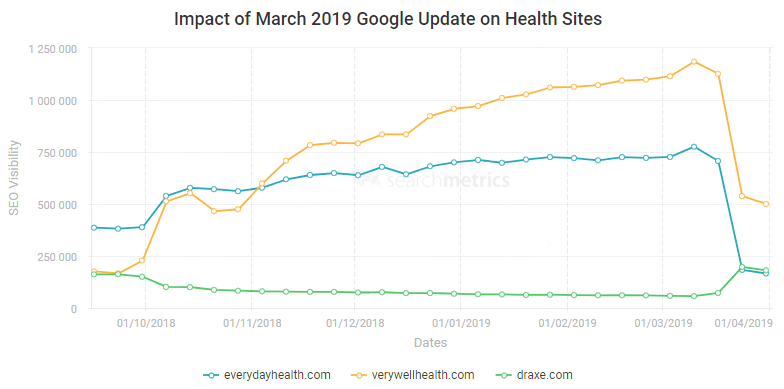
In hindsight, this change in traffic was probably closely related to the algorithm update featuring BERT and RankBrain models.
Just a few months later in June 2019, another core algorithm update rolled out as noted by @searchliaison.
For those asking, the June 2019 Core Update has not gone live yet. This thread will be updated when that process has begun.
— Google SearchLiaison (@searchliaison) June 3, 2019
This algorithm update was rumored to favor unique and quality content. Google later confirmed another part to the update that forced more variety in search results.
Have you ever done a search and gotten many listings all from the same site in the top results? We’ve heard your feedback about this and wanting more variety. A new change now launching in Google Search is designed to provide more site diversity in our results….
— Google SearchLiaison (@searchliaison) June 6, 2019
This portion of the update came as a response to many websites simply “owning” a SERP by having several results within one query. For more detail on this update, the full set of tweets can be viewed here. Again, in hindsight, there is a good chance this update was testing-related in regards to the eventual BERT algorithm, with additional testing around content diversity and how that impacts user intent.
The last core algorithm update release prior to BERT was pushed in September 2019. This update was publicly tweeted by @searchliaison naming the update the now standard “[Month Year] Core Algorithm Update.”
Later today, we are releasing a broad core algorithm update, as we do several times per year. It is called the September 2019 Core Update. Our guidance about such updates remains as we’ve covered before. Please see this blog for more about that: https://t.co/e5ZQUAlt0G
— Google SearchLiaison (@searchliaison) September 24, 2019
This was one of the rare cases that Google released a corresponding blog post on their webmaster blog to help inform the community about the impending update. It contained vague advice on how to handle this algorithm update and it noted content as the “thing” website owners should focus on. Google also noted changes to the QRG in this blog citing several reviews and industry blog posts.
Defining Quality Content
2019 was a year that saw somewhat regular updates to the Quality Rater Guidelines (QRG) and an emphasis on what constitutes “quality content.” Google shared more information about Your-Money-Your-Life (YMYL) queries and the Expertise, Authority, and Trustworthiness (E-A-T) of your content.
The first changes to the QRG were announced in May (which was almost a whole year since the last change in content guidelines). With this update, E-A-T became synonymous with Page Quality. SearchEngineLand did a great review of this update and noted one major addition that shows how E-A-T can be used to help judge page quality.
Not long after the May guideline update, Google again updated the QRG in anticipation of the September 2019 core algorithm launch. Again, SearchEngineLand had a very thorough post reviewing the changes giving us a look at the old QRG and the updated content. This time around, there were numerous changes, the biggest regarding content quality and how it relates to YMYL queries.

Additional context was added for E-A-T and content publishers.
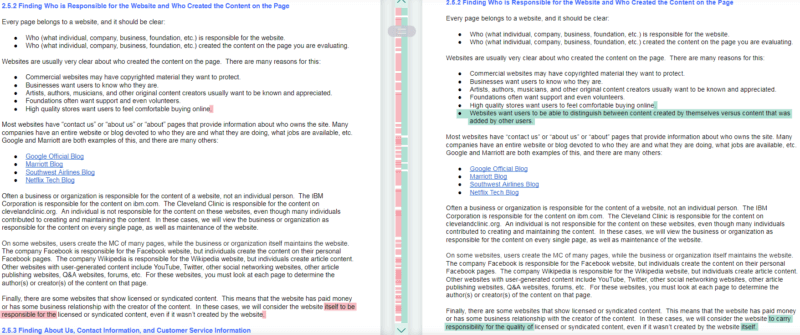
In the new section, the QRG stated, “Websites want users to be able to distinguish between content created by themselves versus content that was added by other users.” Implementing this change attempted to combat the spread of misinformation. While this implementation was done to prevent the inevitable harm that perpetuating bad or inaccurate information can cause, it was also to control content that Google doesn’t like. Overall, it is safe to say how Google defines quality content changed significantly over 2019.
Search Intent Understanding and BERT
2019’s largest algorithm update rolled out at the end of October. This update was the only one that did not follow the previous naming pattern, and was instead dubbed the “BERT algorithm update.” BERT stands for Bidirectional Encoder Representations from Transformers, and is an open-source technology that Google released in 2018 to help train natural language processors for delivering search results. This update incorporated the data gathered over the course of the previous year to give insight on intent-specific results.
This understanding fundamentally changes who or what is considered “relevant” for millions of queries. For clarity and reference, Google shared a few before-and-after examples to demonstrate this newfound understanding of intent-driven search:
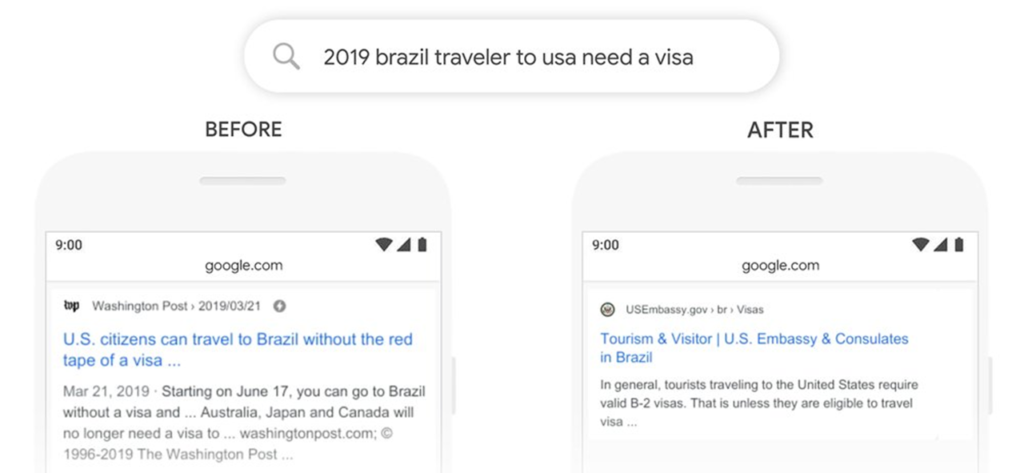
In the example above, it is clear what the searcher is trying to find. However, the previous algorithms intent could be slightly off, which led to a less relevant SERP given the question.
With Google understanding intent better, it effectively enables them to be able to help answer queries more effectively. This significantly improves the SERPs in general. Because of this better intent understanding, there are millions of queries that are now receiving completely different search results from before. Most of these are more accurate and more relevant than they were previously.
Google claimed The BERT algorithm update was their biggest in the past five years, with an estimated 10% of all search queries being directly affected by the update. For comparison, the last major update that would have significant updates on queries was the mobile-friendly update (April 2015),which never disclosed its impact.
The BERT algorithm update ultimately ushers in a new era of connecting a user’s actions with content. This means means it’s not just quality content that matters—it’s about helping searchers accomplish their goals or tasks. The purpose of the SERPs has shifted from providing content that could answer a question to providing content that helps users take action. In hindsight, we see that the changes and updates implemented throughout most of 2019 were in preparation for this update.
Of course, the integration of BERT into Google’s core algorithm helps drive better voice search results. This leads us right into the next major highlight from 2019.
Voice Search Growth
In line with 2018 predictions, the growth of voice search was massive. Microsoft released a case study where 69% of respondents stated they had used voice search by February of 2019. Based on this data, the case studies estimated that 75% of households in the United States would have at least one smart speaker by 2020. Industry leaders considered this an important metric, as voice search queries and the subsequent results would inevitably affect lead generation. The case study confirmed this, as over half of the study participants stated they would use voice search to begin making purchases within the next five years.
Voice search is primarily driven by native data sources, with technology proprietary to the assistant being used. For example, if you are searching for a product on an Amazon Echo speaker, most of your results will be driven by Amazon’s own data and only occasionally by external search sources like Google.
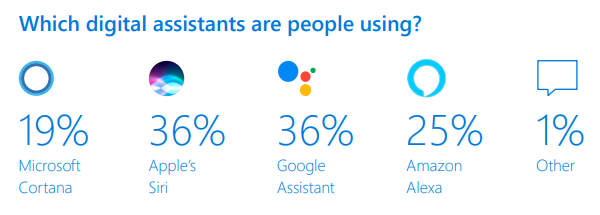
Because of the proprietary nature of these devices, you should do everything in your power to provide data that every system can read. Structured or micro data plays heavily into featured or direct answers provided by voice search. Many businesses have been avoiding implementing markup data, since there hasn’t been a direct ROI deliverable. But now, voice search is beginning to show what benefits having structured data can provide.
As voice search’s popularity and growth are expected to rise, it seems like a huge opportunity for many businesses. However, businesses should still exercise caution. Because it’s relatively new to the marketplace, it may not be a good fit for everyone. For example, it is unlikely users will begin ordering high-ticket items like TVs and cars from voice search. If you sell or promote products like these, investing in voice search won’t be the most profitable option right now. But if you’re in a service-based industry, data suggests business in that arena may find better success.
Increase Privacy Standards (CCPA & GDPR)
The General Data Protection Regulation (GDPR) was introduced in May of 2018. It standardized the set of regulations that protects users in all EU member states. This regulation requires companies to build privacy settings into their digital products and websites and have them switched on by default. The California Consumer Privacy Act (CCPA), passed in June 2018 in response to the Cambridge Analytica scandal, is the most comprehensive data privacy law in the US to date. The act went into effect on January 1, 2020, and like the GDPR, provides certain rights to consumers including the right to know, the right to access, the right to opt-out and the right to deletion.
Over the past year, marketers have been working to adjust their campaigns to adhere to new privacy standards. Thanks to their preemptive efforts, it’s now rare to see a website that doesn’t ask about cookies when users arrive on the site. Users also have more control over their data than ever before. In addition, search engines like DuckDuckGo have been seeing an increase in participation, proving that people are looking for higher privacy standards.
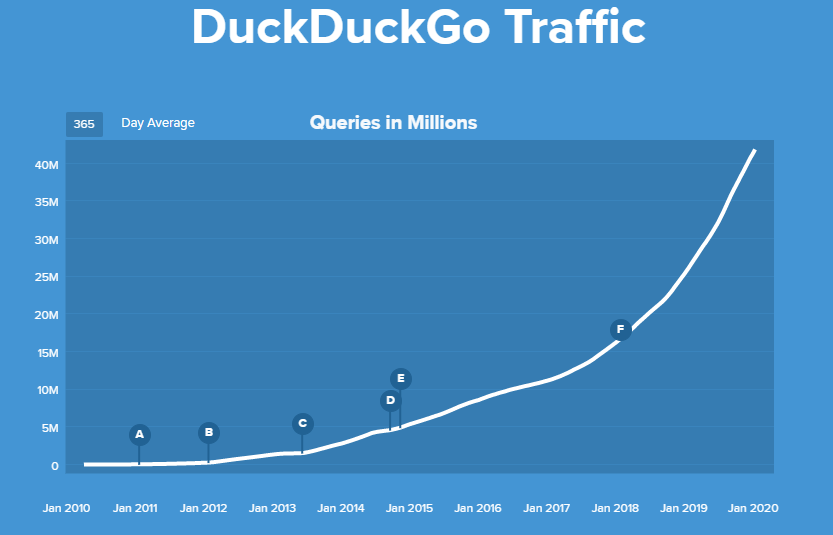 2019 saw a shift in the general population as users became more aware of privacy standards and took back control from large data companies. As 2020 strategies are being flushed out, be sure to keep new privacy standards in mind.
2019 saw a shift in the general population as users became more aware of privacy standards and took back control from large data companies. As 2020 strategies are being flushed out, be sure to keep new privacy standards in mind.
2020 Predictions
Over the next year, we’re sure there will be changes in regards to organic search and SEO in particular. We predict that the rise and adaptation of mobile visitors will be an even bigger focus in 2020. We’re certain that this focus towards mobile-first will require better content understanding, especially in light of the BERT update.
Creating actionable content rather than just satisfying a word count will improve SEO efforts in 2020. This could also lead to more digital automation where many website needs can run themselves autonomously. We are also predicting that the organic space will lose visibility due to the rise of more paid content avenues. Keep reading to see exactly what we predict and how we see 2020 playing out for organic search.
Mobile First Content & Function
The need to be mobile-friendly is certainly not new. Google switched to mobile-first indexing in 2019, making it a bit of a stale topic, especially for businesses. However, this is where we suspect a renewed effort will be applied in 2020. What should businesses do and how can they prepare for more of this type of traffic? We believe integrations like clickable phone numbers and schedulers that work with mobile devices will rise in popularity as users come to expect a certain type of usability from the site.

There is a good chance that increasing your website’s functionality for mobile users will be the next boosted signal for search engines. Business should consider adding click-to-action type elements to their site or modifying keyboards that pop-up to fill forms. You can do some of these things quickly with microdata implementation.

The need to facilitate mobile users is now a requirement that every website should take seriously. Increasing usability will only help businesses and their users, which is exactly what search engines want to reward.
Content Understanding
With search updates like Panda, Medic, and BERT, it is becoming evidently clear that intent and understanding how content can serve a user is paramount. Search engines like Google are striving to better understand and reward quality content. But what constitutes quality?
The latest October 2019 update (BERT) was a massive step towards better machine learning and curating a cleaner search intent with natural language integrations. Because of this, we predict search engines will continue to understand how content should work to support user goals and understand searcher intent. This is also where publisher association, reputation, and frequency could become a larger ranking factor. (Think E-A-T and the QRG).
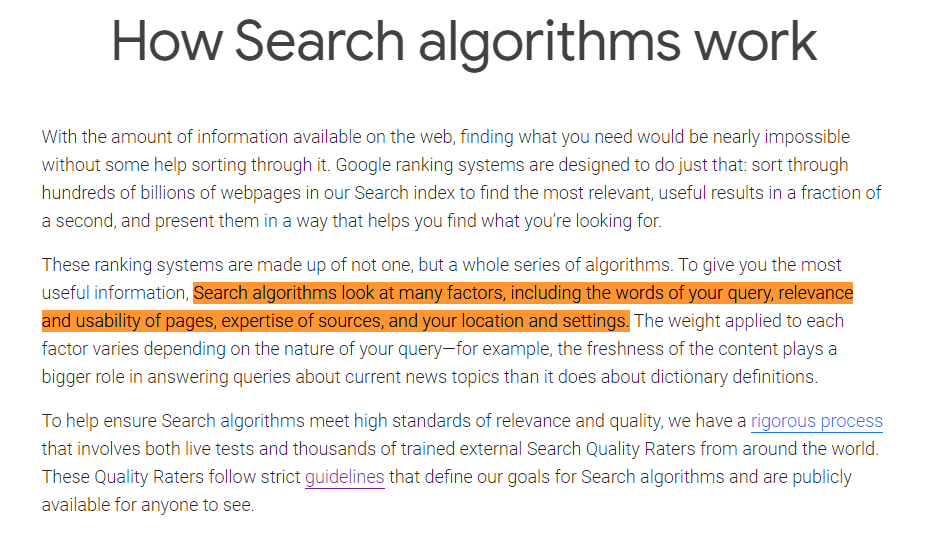
In 2020, a website’s content will need to be robust enough to support the structure of the site. For example, having a page with a block of text and a lead form will probably not be considered quality content going forward. But if the page offered quality text, images, tables or an interactive tool, search engines will see a better cohesion between your other content. There is a good chance more comprehensive content will become the new standard for what constitutes quality content. We have already begun to see this in highly competitive markets and industries, but we expect this to become a more general standard for everyone going forward in 2020.
Another factor that will play into 2020 content understanding is entity matching and association. Specifically, this would emphasize who is publishing content and understanding why it was published. In 2019, we saw a change in how no-follow links are branded, which indicates that this will be of importance going forward. If a brand has dedicated writers that produce content regularly, their content may receive a boost, while a random writer on the same site may get held back.
Entity matching could eventually lead to a more organic impact. Image search could also become more entity-based, giving brands more influence regarding their expertise. Having your site’s content cited and attributed by search engines will have an increased impact on rankings in 2020. We predict that this is going to bleed into other search features like featured snippets.
Action vs. Content
As with most of the updates we’re predicting for 2020, it all leads back to a better user experience. And a great user experience is determined by a site’s ability to provide actionable items for a user to implement. It is this notion of action integrated with content that we predict will outweigh raw content alone.
We predict sites that allow users to make their interactions with the business as easy as possible will see increased rankings. These types of integrations are made easy on SERPs with tools like Google My Business. If you inspect this particular tool, you will find that it offers a lot of options for a small business to build their profile. The functionalities offered should be viewed as indicators of what Google views as quality. Sites that use functions similar to these will see more search inclusion and go higher in the search rankings compared to someone who simply has extensive amounts of text. This is because a better user experience allows the user to accomplish a task more effectively.
We recognize that there certainly is quite a bit of nuance and flexibility around this prediction but the general idea is that what search engines perceive as “quality content” is going to evolve in 2020. Much like 2019 saw testing of BERT models and the eventual release the actions of a user will begin to evolve. We will see this emphasis on quality content extend into the customer journey and what actions are taken by the user in the end. If you have a simple submission form with a smattering of content that will not be enough if a competitor offers online booking, real-time communication and/or an interactive tool.
These types of action-based interactions extend into a website’s usability and how that is used as a ranking metric. If you get more people clicking and staying on a result it’s a clear sign that the site is a good fit for the queries being performed. A website’s functionality could heavily alter how this usability is viewed and measured.
Website and Online Automation
Stemming from AI advancements and repetitive task management comes the rise of website automation. We are predicting this will be fairly pressing need for many websites heading into the new decade. We’re seeing these changes already with tools like chatbots and AI optimized ad campaigns.
Other services have started to show up around social posting, content creation, and even customer service. We suspect many websites and businesses will adopt these automations to help improve their services and products. On the extreme end, we could begin seeing this automation leak into branding.
But beware—this kind of advanced and holistic automation could cause some issues around quality content and brand expertise. If enough effort isn’t put into integration, you can get impersonal and lose a potential customer or damage your brand. If automation in any way affects the customer journey, search engines may soon be able to identify and penalize such actions. Either way, we expect website automation especially around customer interaction to increase in 2020.
Pay-to-Play
Naturally, we saved the best (and worst) point for our last 2020 SEO prediction. This prediction is actually a 2019 trend that we believe will continue well into 2020. Unfortunately, it has been a common trend over the past few years that paid advertising is creeping into the once plentiful organic search results. We have seen this manifest itself in a few key ways since its initial growth in 2016 that gave us a glimpse at where we are headed.
In as early as August of that year, it started to become clear that paid search was changing and carving out its own niche away from organic traffic. One of the first major changes was the switch from specific search volumes in keyword planner to aggregated search ranges. Over the years, there have been several tests that have shifted how ads appear in organic results. Other changes have modified the amount of ads and where they display on the page, with some search results showing ads that account for 50% of content above the fold.
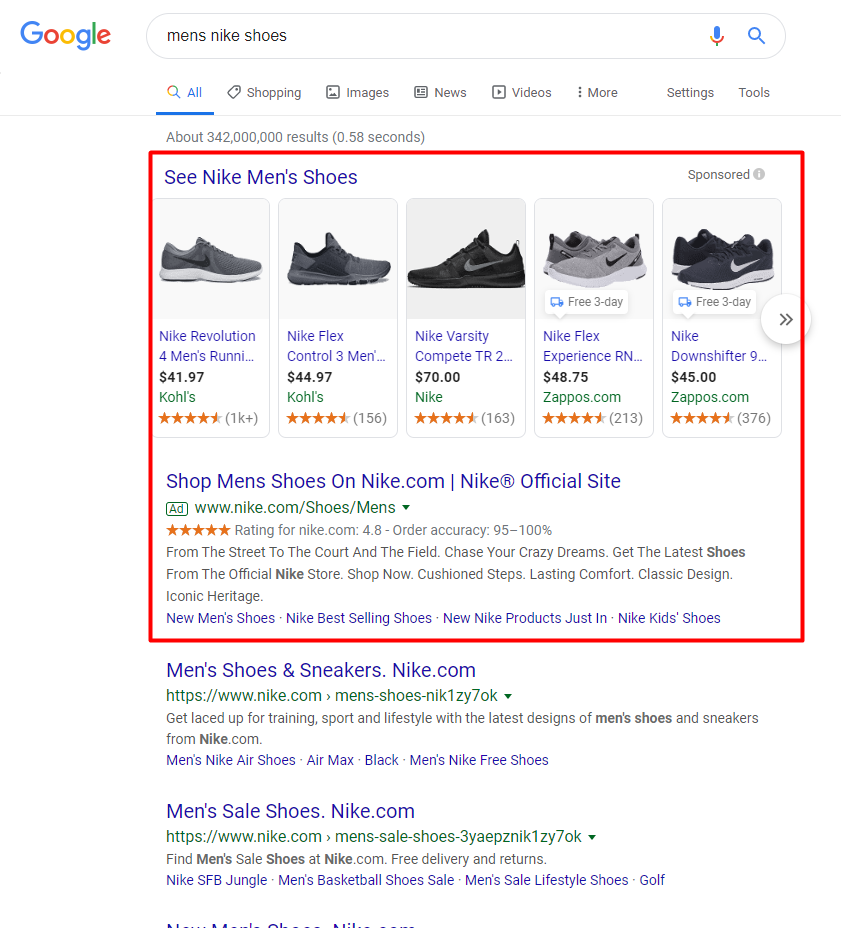
This over-stuffing of ads into organic placement is worse on mobile devices. Some queries show upwards of three full screens of ads before organic results.
The latest ad placement invasion has been seen in the maps section on Google. Previously this was 100% organically driven. It now has sponsored ads that appear above any organic listings. These ads often appear slightly different but seem more ‘featured’ than noted as a sponsored listing.
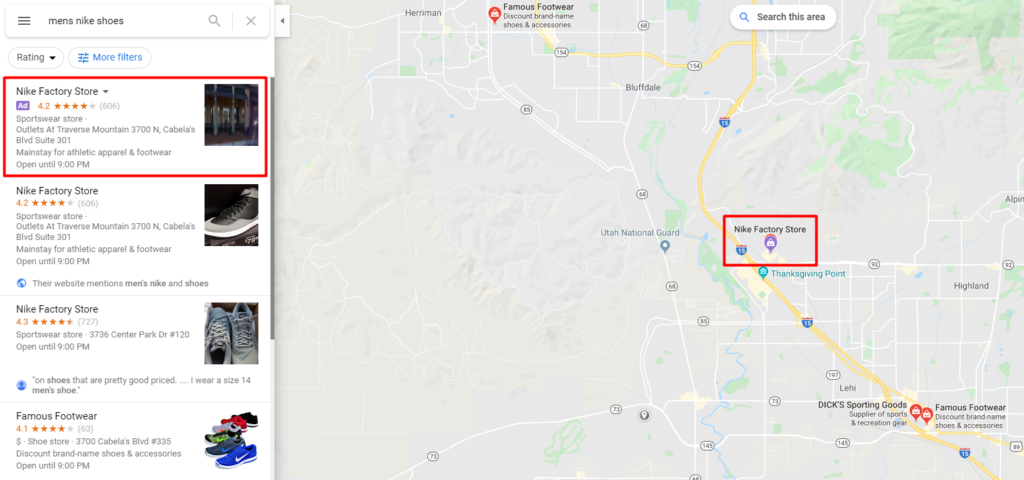
Given the history of ads and their encroachment into organic results. We believe this trend will most certainly continue in 2020. It is not out of the realm of plausibility to assume that we may be looking at paying for premium search features, such as removing competitors from listings, specialty fields in profiles, special ad placement, or highlights.
And if that wasn’t worrisome enough, voice search may also be giving into the pull of advertisements in the near future. Given its growth as a medium and ambiguity around inclusion and use, it could be the next best thing for paid advertisement, and could eventually replace once organic-driven results and answers.
A Quick Summary
In summation, 2020 Boostability predicts that we will see an increase in adoption of:
- Mobile First Content & Function
- Content Understanding
- Action vs Content
- Website and Online Automation
- Pay-to-Play Increases
Want even more information to make sure your SEO strategy is as effective as possible? Head to our services page to learn more.

